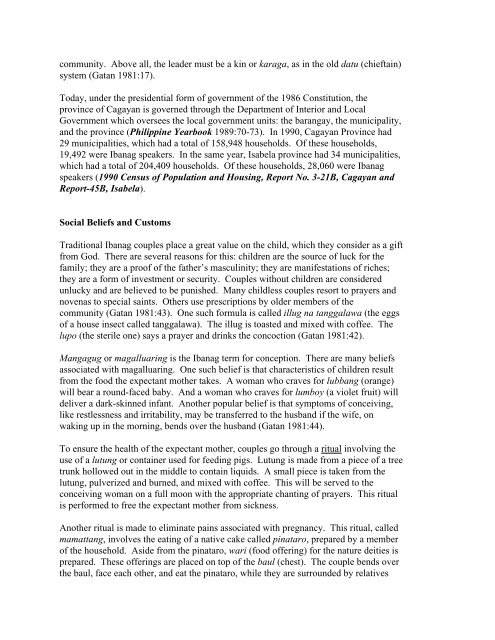The word “Ibanag” derives from the prefix “i” meaning ... - Buffalo
The word “Ibanag” derives from the prefix “i” meaning ... - Buffalo
The word “Ibanag” derives from the prefix “i” meaning ... - Buffalo
You also want an ePaper? Increase the reach of your titles
YUMPU automatically turns print PDFs into web optimized ePapers that Google loves.
community. Above all, <strong>the</strong> leader must be a kin or karaga, as in <strong>the</strong> old datu (chieftain)<br />
system (Gatan 1981:17).<br />
Today, under <strong>the</strong> presidential form of government of <strong>the</strong> 1986 Constitution, <strong>the</strong><br />
province of Cagayan is governed through <strong>the</strong> Department of Interior and Local<br />
Government which oversees <strong>the</strong> local government units: <strong>the</strong> barangay, <strong>the</strong> municipality,<br />
and <strong>the</strong> province (Philippine Yearbook 1989:70-73). In 1990, Cagayan Province had<br />
29 municipalities, which had a total of 158,948 households. Of <strong>the</strong>se households,<br />
19,492 were Ibanag speakers. In <strong>the</strong> same year, Isabela province had 34 municipalities,<br />
which had a total of 204,409 households. Of <strong>the</strong>se households, 28,060 were Ibanag<br />
speakers (1990 Census of Population and Housing, Report No. 3-21B, Cagayan and<br />
Report-45B, Isabela).<br />
Social Beliefs and Customs<br />
Traditional Ibanag couples place a great value on <strong>the</strong> child, which <strong>the</strong>y consider as a gift<br />
<strong>from</strong> God. <strong>The</strong>re are several reasons for this: children are <strong>the</strong> source of luck for <strong>the</strong><br />
family; <strong>the</strong>y are a proof of <strong>the</strong> fa<strong>the</strong>r’s masculinity; <strong>the</strong>y are manifestations of riches;<br />
<strong>the</strong>y are a form of investment or security. Couples without children are considered<br />
unlucky and are believed to be punished. Many childless couples resort to prayers and<br />
novenas to special saints. O<strong>the</strong>rs use prescriptions by older members of <strong>the</strong><br />
community (Gatan 1981:43). One such formula is called illug na tanggalawa (<strong>the</strong> eggs<br />
of a house insect called tanggalawa). <strong>The</strong> illug is toasted and mixed with coffee. <strong>The</strong><br />
lupo (<strong>the</strong> sterile one) says a prayer and drinks <strong>the</strong> concoction (Gatan 1981:42).<br />
Mangagug or magalluaring is <strong>the</strong> Ibanag term for conception. <strong>The</strong>re are many beliefs<br />
associated with magalluaring. One such belief is that characteristics of children result<br />
<strong>from</strong> <strong>the</strong> food <strong>the</strong> expectant mo<strong>the</strong>r takes. A woman who craves for lubbang (orange)<br />
will bear a round-faced baby. And a woman who craves for lumboy (a violet fruit) will<br />
deliver a dark-skinned infant. Ano<strong>the</strong>r popular belief is that symptoms of conceiving,<br />
like restlessness and irritability, may be transferred to <strong>the</strong> husband if <strong>the</strong> wife, on<br />
waking up in <strong>the</strong> morning, bends over <strong>the</strong> husband (Gatan 1981:44).<br />
To ensure <strong>the</strong> health of <strong>the</strong> expectant mo<strong>the</strong>r, couples go through a ritual involving <strong>the</strong><br />
use of a lutung or container used for feeding pigs. Lutung is made <strong>from</strong> a piece of a tree<br />
trunk hollowed out in <strong>the</strong> middle to contain liquids. A small piece is taken <strong>from</strong> <strong>the</strong><br />
lutung, pulverized and burned, and mixed with coffee. This will be served to <strong>the</strong><br />
conceiving woman on a full moon with <strong>the</strong> appropriate chanting of prayers. This ritual<br />
is performed to free <strong>the</strong> expectant mo<strong>the</strong>r <strong>from</strong> sickness.<br />
Ano<strong>the</strong>r ritual is made to eliminate pains associated with pregnancy. This ritual, called<br />
mamattang, involves <strong>the</strong> eating of a native cake called pinataro, prepared by a member<br />
of <strong>the</strong> household. Aside <strong>from</strong> <strong>the</strong> pinataro, wari (food offering) for <strong>the</strong> nature deities is<br />
prepared. <strong>The</strong>se offerings are placed on top of <strong>the</strong> baul (chest). <strong>The</strong> couple bends over<br />
<strong>the</strong> baul, face each o<strong>the</strong>r, and eat <strong>the</strong> pinataro, while <strong>the</strong>y are surrounded by relatives
















